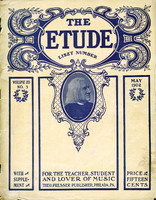Education in musical color is left generally to the haphazard process of unconscious tuition. So far as the general public is concerned, the brass band, the theater orchestra, and the pipe-organ offer the usual means by which the people absorb some notion of the difference in the quality of tones. In comparison with the others, the organ has one advantage in being able to present four-part harmony in one homogeneous color.
For example, one can play the tune “Hursley” with a uniform flute quality on the organ. How could it be done in the band or orchestra? For almost all practical needs the different individual stops “run through,” and so have a much larger range than the corresponding orchestral instruments. And this point is emphasized when we consider the different colors of tone produced by the same instrument; for example, the tones of the violin G and E strings. Compare any string stop—take the Geigen Principal—and the greater homogeneity will be apparent at once.
In making such comparison there is no thought of claiming that the violin stop is an exact imitation of the color of the orchestral violin. Every string stop of the organ has its own tint or hue, just as each string of the violin has.
The Organ has its Own Color.
And a combination of all the string stops of the average three-manual organ gives a rich color-scheme sui generis. The small scale and winding of the pipes bring out those upper partial notes that give the tones their thin and incisive quality. And if we take a broad sostenuto ’cello passage and play it on the organ with the combined eight-foot string stops, the similarity in timbre will be marked.
With the means at his command, there is no reason why the organist should strive to imitate orchestral colors except in transcriptions from orchestral scores. The different hues of string, reed, flute, and organ-colors should furnish him material enough to make endless color-schemes. And the modern tendency toward making the whole organ a swell organ adds to the possibilities of giving expression to the voices of each manual in solo or harmony passages. The swell pedal already permits us to make a fairly good accent, no doubt it will be further improved, to become more immediately responsive to sudden dynamic changes.
Registration for Color.
Every student is forewarned that there is a great temptation for the church organist to fall into a rut in the matter of registration. The demands of the usual church-service soon show him that there is a certain combination that serves as a normal one for the majority of purposes, and which will permit him to make changes without too much manipulation of mechanical accessories. Furthermore, the services of the non-liturgical churches will easily confirm him in this habit. For ordinarily the prelude is played under untoward circumstances, the people coming into church, removing garments, getting their books ready for the service, etc.; and this indifferent atmosphere reacts upon the organist. As the most natural consequence, he soon slips into a habit of choosing preludes that do not demand too many changes in registration. This is true of the postlude, too. And the hymns, as sung by the average congregation, leave little opportunity for much change in color. In fact, the organist of such a church finds his most encouraging moment in accompanying the choir in responses and anthems. It happens also that the anthem is the one point of the service when the audience is in the proper attitude of quiet and attention to take in the color-effects. An organ-solo during the collection gives the same chance.
Happily, there is a growing appreciation of fuller liturgical services among all denominations. And the different responses, versicles, and even amens give the organist a fine occasion to use various color-masses. The great danger is that he may be content to play his accompaniments in the same brown color throughout, especially if the congregation attempts to join in the singing. Unfortunately, too many fall into this “cathedral” habit and rely upon the combination pedals to vary the volume of sound, without giving much heed to the difference in color. The fatal facility of the great crescendo pedal simply aggravates this tendency to magnify the dynamics of the organ as over against its color-possibilities.
Mechanical Aids to Color.
Another habit that helps to neutralize the distinctively color contrasts is that of coupling the manuals too much. The organist feels that it is only by coupling with manuals having a swell pedal that he can produce any crescendo and diminuendo. And the more expressively he wishes to play, the more likely he is to rebel against the solid dynamic level of tone of the manuals unconnected with a swell mechanism. Here it becomes a question whether he shall registrate for greater expressional possibilities or for greater color-variations.
In saying these things we are not forgetting that the use of the great crescendo pedal and of the couplers does affect the coloring, but we wish to accentuate the point that their effects are not perceived as color-effects, but rather as variations in intensity.
The trend toward adding to the organ more varieties of string and flute registers makes it more possible for the organist to present the most agreeable contrasts in color by keeping the manuals uncoupled and giving each a color-mass of its own. It might be practicable for us to suggest to the modern organ-builder that the organist would be grateful for a set of combination pedals or pistons to operate different color-masses, just as large organs now have their reeds on separate accessories.—William Benbow.



